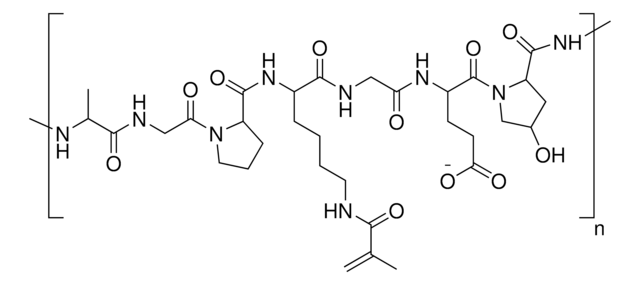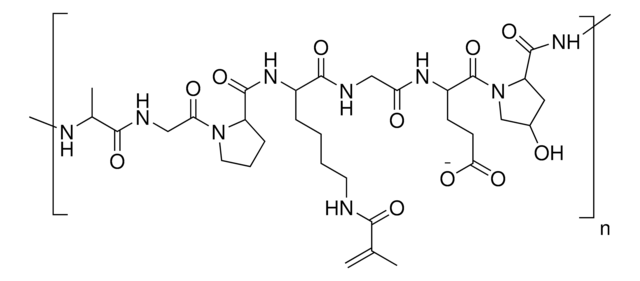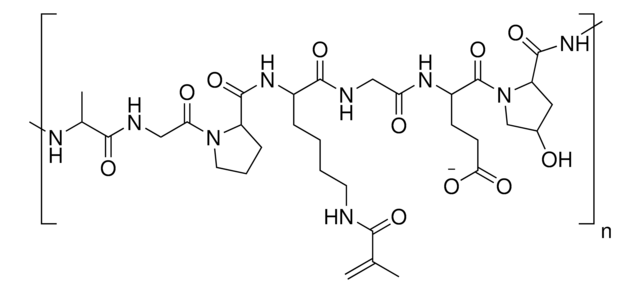おすすめの製品
品質水準
フォーム
(Powder or Chunk(s) or Fibers )
不純物
<10 CFU/g Bioburden
<125 EU/g Endotoxin
色
white to pale yellow
保管温度
2-8°C
類似した製品をお探しですか? 訪問 製品比較ガイド
アプリケーション
This product is low endotoxin version GelMA and ready to be used in biomedical applications.
GelMA can be used to form hydrogels for tissue engineering and 3D bioprinting. Gelatin methacryloyl (GelMA) is a polymerizable hydrogel material derived from natural extracellular matrix (ECM) components. Due to its low cost, abundance, and retention of natural cell binding motifs, gelatin has become a highly sought material for tissue engineering applications. The addition of photocrosslinkable methacrylamide functional groups in GelMA allows the synthesis of biocompatible, biodegradable, and non-immunogenic hydrogels that are stable in biologically relevant conditions and promote cell adhesion, spreading, and proliferation.
GelMA can be used to form hydrogels for tissue engineering and 3D bioprinting. Gelatin methacryloyl (GelMA) is a polymerizable hydrogel material derived from natural extracellular matrix (ECM) components. Due to its low cost, abundance, and retention of natural cell binding motifs, gelatin has become a highly sought material for tissue engineering applications. The addition of photocrosslinkable methacrylamide functional groups in GelMA allows the synthesis of biocompatible, biodegradable, and non-immunogenic hydrogels that are stable in biologically relevant conditions and promote cell adhesion, spreading, and proliferation.
包装
500 mg in glass bottle
保管分類コード
11 - Combustible Solids
WGK
WGK 3
引火点(°F)
Not applicable
引火点(℃)
Not applicable
適用法令
試験研究用途を考慮した関連法令を主に挙げております。化学物質以外については、一部の情報のみ提供しています。 製品を安全かつ合法的に使用することは、使用者の義務です。最新情報により修正される場合があります。WEBの反映には時間を要することがあるため、適宜SDSをご参照ください。
Jan Code
918628-VAR:
918628-BULK:
918628-1EA:
最新バージョンのいずれかを選択してください:
Xin Zhao et al.
Advanced healthcare materials, 5(1), 108-118 (2015-04-17)
Natural hydrogels are promising scaffolds to engineer epidermis. Currently, natural hydrogels used to support epidermal regeneration are mainly collagen- or gelatin-based, which mimic the natural dermal extracellular matrix but often suffer from insufficient and uncontrollable mechanical and degradation properties. In
Jason W Nichol et al.
Biomaterials, 31(21), 5536-5544 (2010-04-27)
The cellular microenvironment plays an integral role in improving the function of microengineered tissues. Control of the microarchitecture in engineered tissues can be achieved through photopatterning of cell-laden hydrogels. However, despite high pattern fidelity of photopolymerizable hydrogels, many such materials
Anh H Nguyen et al.
Acta biomaterialia, 13, 101-110 (2014-12-03)
Gelatin has been commonly used as a delivery vehicle for various biomolecules for tissue engineering and regenerative medicine applications due to its simple fabrication methods, inherent electrostatic binding properties, and proteolytic degradability. Compared to traditional chemical cross-linking methods, such as
Chaenyung Cha et al.
Biomacromolecules, 15(1), 283-290 (2013-12-19)
Microfabrication technology provides a highly versatile platform for engineering hydrogels used in biomedical applications with high-resolution control and injectability. Herein, we present a strategy of microfluidics-assisted fabrication photo-cross-linkable gelatin microgels, coupled with providing protective silica hydrogel layer on the microgel
Luiz E Bertassoni et al.
Biofabrication, 6(2), 024105-024105 (2014-04-04)
Fabrication of three dimensional (3D) organoids with controlled microarchitectures has been shown to enhance tissue functionality. Bioprinting can be used to precisely position cells and cell-laden materials to generate controlled tissue architecture. Therefore, it represents an exciting alternative for organ
ライフサイエンス、有機合成、材料科学、クロマトグラフィー、分析など、あらゆる分野の研究に経験のあるメンバーがおります。.
製品に関するお問い合わせはこちら(テクニカルサービス)






